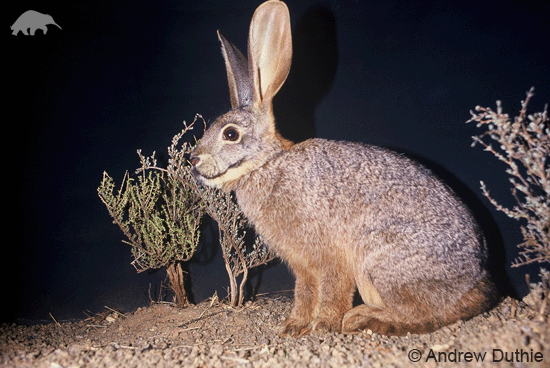Riverine rabbit
The Bushman Hare ( Bunolagus monticularis ) is a mammal native to South Africa from the family of hares ( Leporidae ). He is considered one of the rarest and most endangered mammal species at all.
Features
The dense, silky fur of the Riverine Rabbit is greyish at the top, the sides are reddish, and the belly white. This species has a striking red patch on the neck. His ears are very long, bushy tail is brownish in color. The animals reach a head -body length 34-47 centimeters and a weight of 1 to 1.9 kg.
Dissemination
This rabbit dwelling lives exclusively in bush -lined river banks in the Karoo desert in western South Africa.
Way of life
It is nocturnal and spends the day in small soil pits in the shade of bushes. Their areas are relatively large, the covers of the males an average of 21 hectares, the females around 12 hectares. Their diet consists of flowers, leaves and grasses.
The animals have a polygamous mating behavior, that is a male propagates with several females. Subsequently, the female digs a small earthwork, they auspolstert with grass and fur. The single offspring that comes after about five weeks of gestation period for the world, naked and blind at birth. There can be up to two births in the year, but the rate of reproduction for bunny situation is very low.
System
Pikas ( Ochotonidae / Ochotona )
Busch rabbits ( Poelagus marjorita )
Rotkaninchen ( Pronolagus )
Stripe rabbit ( Nesolagus )
Volcano rabbit ( Romerolagus diazi )
Wild rabbits (Oryctolagus cuniculus)
Bristle rabbits ( Caprolagus hispidus )
Bushman Hare ( Bunolagus monticularis )
Ryukyu Rabbit ( Pentalagus furnessi )
Cottontail rabbits ( Sylvilagus )
Dwarf rabbits ( Brachylagus idahoensis )
True hares (Lepus )
The Bushman Hare is assigned as a distinct species and monotypic genus the rabbit ( Leporidae ). Within the species, no subspecies are distinguished. The first scientific description of the species and the genus was made in 1829 by Oldfield Thomas.
On the basis of molecular biological data was Conrad A. Matthee et al. 2004, a cladogram developed that represents the phylogenetic relationships of the genera within the bunnies to each other. Thus, the Bushman Rabbit is the sister species of the Ryukyu Islands only, Japan spread, Ryukyu Rabbit ( Pentalagus furnessi ) and forms a taxon. This is offset by a taxon from the wild rabbit (Oryctolagus cuniculus) and the bristle rabbits ( Caprolagus hispidus ), while living in America, cottontail rabbits ( Sylvilagus ) and the Dwarf ( Brachylagus idahoensis ) is the sister group of these four types.
Threat and protection
Riverine Rabbit are among the rarest mammals. First discovered in 1902, the species was sometimes decades to be lost (for example 1948-1979 ). The main problem is the conversion of its habitat to agriculture, as more than 60 percent of its potential habitat has been lost in recent decades. Their habitat is completely privately owned by farmers, with training programs should be pointed to the threat of this kind. The predation by dogs and possibly hunting play a role. Recent estimates are based on no more than 250 live specimens.
Naming
Interestingly, wears the type the name Bushman "hare", although she has rabbit -like properties, so life in burrows or nest squatting pups. Presumably this was the similarity to the genuine rabbits, especially in the long ears, decisive. In English, however, it is called Riverine Rabbit or Bushman, ie rabbits.






q(95)/506d64e452f5ecd3630d96f12972f8c7.jpg)



